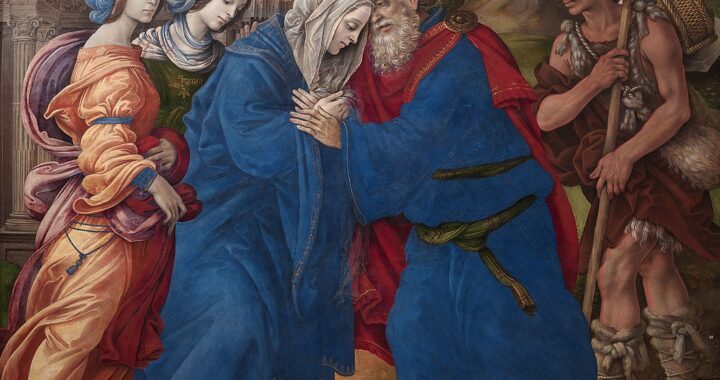
When my book about saints was first released, I was interviewed by Michael O’Neill, better known as the creator and host of the EWTN television show, Miracle Hunter. Before our interview started, I mentioned to him that I was interested in his out-of-print book, 365 Days with Mary. He told me that he was working on a new version, which I am hoping will be released sooner rather than later.
Personally, I have found the Catholic liturgical year to be invaluable in keeping my days, months, and years focused on Jesus Christ. That’s why I was intrigued by the premise of his book. That is, could every single day of the year can be linked to a devotion related to the Blessed Mother? There is at least one website offering a calendar of Marian feast days for every day of the year, but I have been hoping that someone would thoroughly research the subject and determine the origins of all of those dates. Are they related to dates when Marian apparitions occurred? Historical sites and events? Theological controversies? All three of the major Marian feast days currently celebrated by the Church in December can be attributed to one of those three causes.
On December 8, the Church celebrates the Solemnity of the Immaculate Conception of Mary. The doctrine of the Immaculate Conception of the Blessed Virgin was defined by Pope Pius IX in 1854 in the papal bull Ineffabilis Deus, and the Catechism of the Catholic Church also includes an explanation of this teaching (see nos. 490-493). Although this definition occurred relatively recently, Catholics have been celebrating local feasts in honor of Mary’s conception (although not her immaculate conception) for over a thousand years, and generally around the date of December 8. For centuries, theologians and saints argued about how to explain Mary’s conception in such a way that it would show proper honor to the Mother of God but without detracting in any way from the Son of God Himself. Finally, in the nineteenth century, the pope confirmed and explained this teaching. If this teaching seems complicated to you, a simple, visual explanation is shown at the top of this article. Steve Ray’s Footprints of God: Mary video also has a memorable visual explanation of the teaching, which can be found in this excerpt on YouTube.
But what day of the year should be chosen for such a celebration? The month of December couldn’t be a better time. As we wait to celebrate the birth of Christ in Advent, we can remember that Mary needed a Savior, just like every other man and woman.
Pope Francis recently restored the commemoration of Our Lady of Loreto and made it an optional memorial in the universal calendar on December 10. Many faithful Catholics are familiar with the prayer called the Litany of Loreto, but there’s more to this celebration than a prayer.
The Basilica della Santa Casa is located in Loreto, Italy. According to tradition, this basilica contains the house in which the Blessed Mother lived in Nazareth. Some say the building was miraculously transported from Nazareth to Italy by angels; some say the house was relocated by a wealthy and aristocratic family with the last name of Angelos. If the latter explanation is true, it is easy to see how people came to believe the former. This Wikipedia page lays out arguments for and against theories about the house’s origin, and it also includes some photos of the lovely statue of Our Lady of Loreto and a beautiful marble screen that has been built around the house.
Why was this date restored to the calendar? Probably because pilgrims have been flocking to Loreto since the Middle Ages, perhaps earlier, and this feast day shows respect for the longstanding devotion of faithful Catholics. Why celebrate on December 10? Because the church in Loreto itself established that tradition. Why remember this date at all? Maybe because, while Wikipedia may scoff at reports of miracles at Loreto, ordinary Catholics do not.
On December 12, the Church celebrates the apparition of Our Lady of Guadalupe in Mexico. In North, South, and Central America, this is commemorated with greater emphasis than elsewhere in the world; it is a feast day in the US.
Most Catholics know the story of Guadalupe, how a peasant named Juan Diego encountered a beautiful woman, how that mysterious woman encouraged him to go to the bishop and ask for a church to be built, how the woman’s image was inexplicably imprinted on his cloak, and how millions of native Americans saw God’s love for them in this miraculous event and became Catholics. There are many other miracles associated with these visions, such as the blooming roses that the Lady pointed out to him—in December— and the fact that Juan’s cloak has survived both the passage of time and a bombing attempt. Since Saint Juan’s final vision of Mary occurred on December 12, 1531, this feast is celebrated on that date.
There are many dates related to the Virgin Mary in the calendar of the Roman Catholic Church. There are even Marian feast days in the Eastern Orthodox Churches, Greek Orthodox Churches, the Greek Catholic Church, Anglican Churches, and Lutheran Churches, although not all are celebrated universally in those churches. But of all the Marian dates in December, the feast of Our Lady of Guadalupe is the most notable—because it is the date that our Blessed Mother apparently chose herself.
